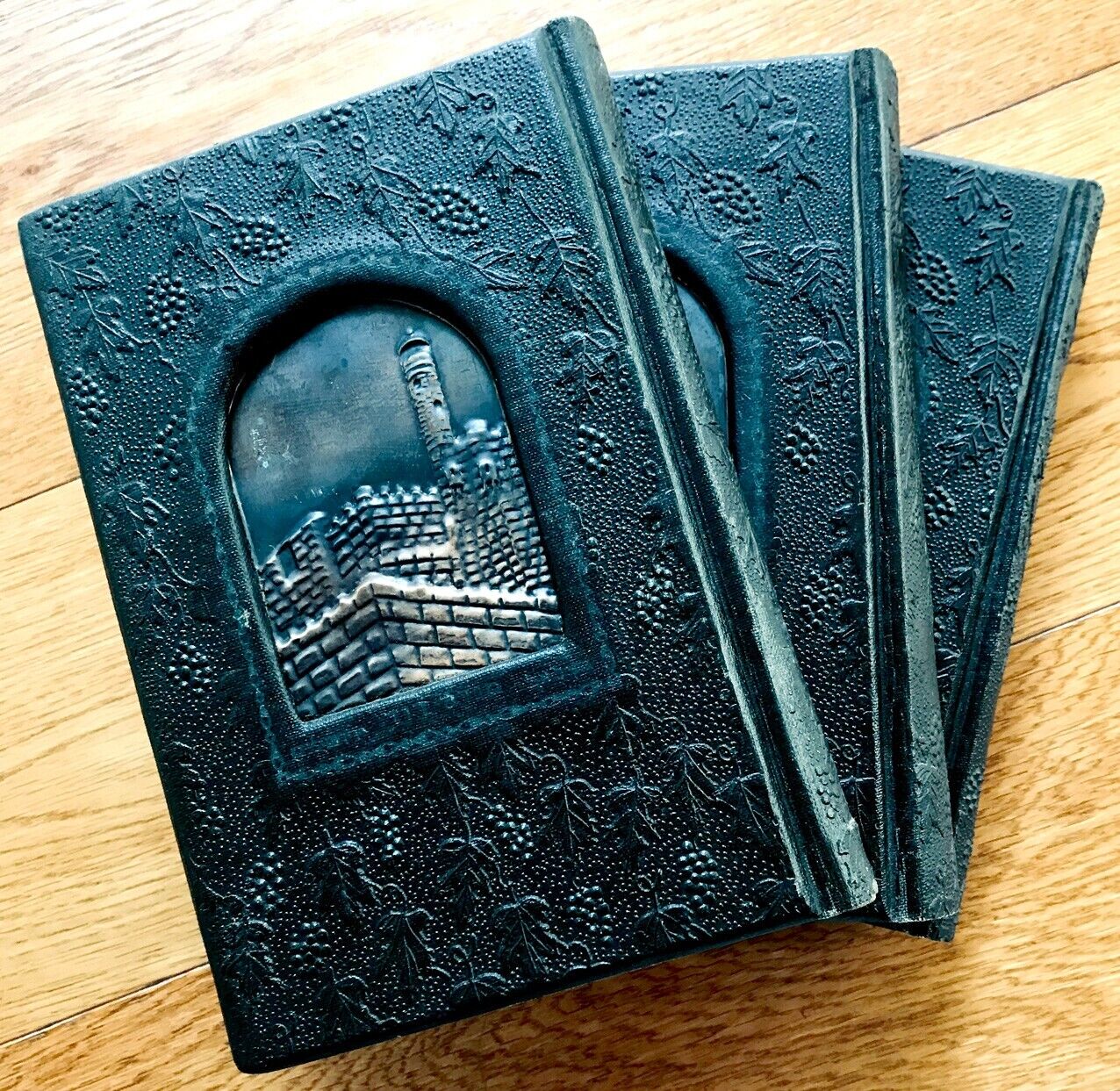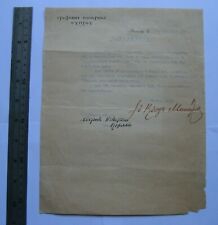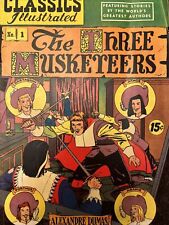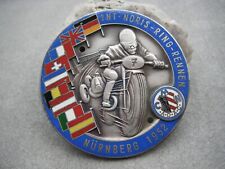1952 Three BEZALEL PRAYER BOOKS Judaica HEBREW Machzor JEWISH Jerusalem ISRAEL

When you click on links to various merchants on this site and make a purchase, this can result in this site earning a commission. Affiliate programs and affiliations include, but are not limited to, the eBay Partner Network.
1952 Three BEZALEL PRAYER BOOKS Judaica HEBREW Machzor JEWISH Jerusalem ISRAEL:
$175.00
DESCRIPTION:Up for sale is an originalMAGNIFICENT LOT of THREE Bezalel illustratedLEATHER IMMITATION covered Judaica JEWISH MACHZORIM BOOKS in HEBREW which were created in 1952 ( DATED ) over 70 years ago in ERETZ ISRAEL ( Then also refered to as Medinat Israel ) by theBEZALEL SCHOOL of ART in JERUSALEM, right after the establishment of the INDEPENDENTSTATE of ISRAEL and its 1948 WAR of INDEPENDENCE .The LEATHER IMMITATION and GENUINE LEATHER BOUND volumes werecreated and published in the very early 1950\'s by LEVIN EPSTEIN in JERUSALEM . The TOP MOUNTED leather immitation BOOKS have a copper plaque - relief , depicting the DAVID TOWER ( Migdal David , David Citadel ) in JERUSALEM and RACHEL\'s TOMB in Beth Lechem.The leather immitation covers with their MOUNTED TOP and WINES DESIGNED PATTERN are a beauty . The MACHZORIN are for ROSH HASHANA ( 268 pp ) , YOM KIPPUR ( Around 400 pp ) and SLOSHA REGALIM ( around 500 pp). Size around 8 x 6 \" . Excellent condition. Unused. Tightly bound. Perfectly clean.( Pls look at scan for accurate AS IS images ) Will be sent inside a protective packaging .
AUTHENTICITY :These are ORIGINALvintage ca very early 1950\'s MACHZORIM BOOKSbound by ORIGINAL BEZALEL LEATHER IMMITATION bindings created in ERETZ ISRAEL , NOT areproduction , Immitation or a reprint , Itholds alife long GUARANTEE for itsAUTHENTICITY and ORIGINALITY.
PAYMENTS : Payment method accepted :Paypal.SHIPPMENT : SHIPP worldwide via registered airmailis $ 39 .Will be sent protected inside a protective rigidpackaging . Handling around 5-10 days after payment.
Bezalel Academy of Arts and Design is Israel\'s national schoolof art, founded in 1906 by Boris Schatz. It is named for the Biblical figure Bezalel,son of Uri (Hebrew: ), who was appointed by Moses to overseethe design and construction of the Tabernacle (Exodus 35:30). The BezalelSchool was founded in 1906 by Boris Schatz. Theodor Herzl and the early Zionistsbelieved in the creation of a national style of art blending classical Jewish/MiddleEastern and European traditions. The teachers of Bezalel developed adistinctive school of art, known as the Bezalel school, which portrayedBiblical and Zionist subjects in a style influenced by the European jugendstil(art nouveau) and traditional Persian and Syrian art. The artists blended \"variedstrands of surroundings, tradition and innovation,\" in paintings andcraft objects that invokes \"biblical themes, Islamic design andEuropean traditions,\" in their effort to \"carve out a distinctivestyle of Jewish art\" for the new nation they intended to build in theancient Jewish homeland. The Bezalel School produced decorative artobjects in a wide range of media: silver, leather, wood, brass and fabric.While the artists and designers were Western-trained, the craftsmen were oftenmembers of the Yemenite Jewish community, which has a long tradition of workingin precious metals. Silver and goldsmithing had been traditional Jewishoccupations in Yemen. Yemenite immigrants were also frequent subjects ofBezalel school artists. Leading artists of the school include Meir Gur Aryeh, Ze\'evRaban, Shmuel Ben David, Ya\'ackov Ben-Dov, Ze\'ev Ben-Tzvi, Jacob Eisenberg, JacobPins, Jacob Steinhardt, and Hermann Struck In 1912, the school had only onefemale student, Marousia (Miriam) Nissenholtz, who used the pseudonym ChadGadya.The school closed down in 1929 in the wake of economic difficulties, butreopened in 1935, attracting many teachers and students from Germany, many ofthem from the Bauhaus school shut down by the respectively) is theprayer bookwhich is used byJewson theHigh Holy DaysofRosh HashanahandYom Kippur. Many Jews also make use of specializedmachzorimon the three pilgrimage festivals ofPassover,Shavuot, andSukkot. Themachzoris a specialized form of thesiddur, which is generally intended for use in weekday andShabbatservices.The wordmachzormeans \"cycle\"; therootח־ז־רmeans \"to return\". The termmachzororiginally referred to a book containing prayers for the entire year, including weekdays andShabbatas well as holidays. Later (first inAshkenazicommunities) a distinction developed between thesiddur, which included weekday and Shabbat prayers, and themachzor, which included festival prayers.[1]Nevertheless, the original type of Machzor containing all of the prayers for the year continued to be used (even if less common) at least into the 20th century.[2]Contents1 Origins and peculiarities2 Popular versions3 See also4 References5 External linksOrigins and peculiarities[edit]Some of the earliest formalJewish prayerbooksdate from the tenth century; they contain a set order of daily prayers. However, due to the many liturgical differences between the ordinary, day-to-day services and holiday services, the need for a specialized variation of thesiddurwas recognized by some of the earliestrabbinic authorities, and consequently, the firstmachzorimwere written incorporating these liturgical variations and additions.Themachzorcontains not only the basic liturgy, but also manypiyyutim, which are liturgical poems specific to the holiday for which themachzoris intended. Many of the prayers in themachzor, including those said daily or weekly on the Sabbath, have special melodies sung only on the holidays. Mostmachzorimcontain only text and no musical notation; the melodies, some of which are ancient, have been passed down orally.Popular versions[edit]Koren Sacks Machzor Series– A growing body of Hebrew-English holiday prayer books that fuses the translation and commentary of Chief RabbiJonathan Sackswith the unique design and layout ofKoren Publishers Jerusalem. The liturgy includes a modern English translation and features prayers for the State of Israel, Israel’s Defense Forces, Welfare of the Government and the Safety of the American Military Forces. The Koren Sacks Rosh Hashanahmachzorwas released in 2011 and was named a 2011National Jewish Book Awardfinalist by TheJewish Book Council.[3]The Koren Sacks Yom Kippurmachzorwas released in 2012 and the Koren Sacks Pesahmachzorwas released in March 2013.The Jewish Presscalls the introduction to the Koren Sacks Pesahmachzor\"a thematic and theological entree to the very essence of Passover.\"[4]The vast majority of the piyyutim are contained in an appendix in the back of the volume and are not translated.ArtScroll Machzor– Very popularmachzorpublished byArtScrolland used both in the Haredi and Modern Orthodox Jewish community. The text has English translations, commentary, scriptural sources, and choreography (when to sit, stand, bow, etc.) Many versions are available. It contains all of the piyyutim ofMinhag Polin(except for Selichot of Shacharit, Musaf and Mincha on Yom Kippur), but some of the piyyutim have been move to an appendix in the back and do not contain translation.Machzor HaShalem: High Holiday Prayerbook– Edited byPhilip Birnbaum. Still used in the Modern Orthodox Jewish community, and for a time in someConservative/Masortisynagogues. The text has English translations, commentary, scriptural sources. This book only went out of print around 2000, after having been used for more than 50 years. Many congregations still use it. It eliminates the vast majority of thepiyyutimfor the 3 Festivals.Roedelheim machzorim - Edited byWolf Heidenheim, these machzorim first came out in the early 19th century. They were printed hundreds of times, and they are still used in manyYekkishcommunities. There are versions of the machzor according to the Western Ashkenazic rite, as well as according toMinhag Polin; the former was also published with an English translation.Daniel Goldschmidt/Jonah FraenkelMachzor - This is an \"academic\" machzor. It includes piyyutim found only in manuscripts, reconstructs customs of Ashkenazic and French communities in the Middle Ages, and contains critical notes and commentaries on all of the piyyutim. The series currently contains 5 volumes for the five major Festivals[5]Additional volumes for the piyyutim of special Shabbatot in preparation by the Goldschimdt/Fraenkel family.Machzor: High Holiday Prayerbook– Edited by Conservative RabbiMorris Silverman, this book became the de facto Conservative Jewishmachzorfor 30 years. The text has explanatory notes, meditations, and supplementary readings. It is still in use in some congregations today. Published by the Prayer Book Press.Machzor for Rosh Hashanah and Yom Kippur– Edited byJules Harlow, the officialmachzorofConservative Judaismfrom the early 1970s until 2009. 816 pages. This text has much less commentary and instruction than othermachzorimpublished in the 20th century. The editors focused on the translation, feeling in most places it would be sufficient. It has somewhat fewer poems than other traditional and Conservativemachzorim. The translations are more poetic and less literal. In 2009 theRabbinical Assemblyand theUnited Synagogue of Conservative Judaismannounced a new successor volume,Machzor Lev Shalem, intended to replace this edition.Machzor Lev Shalem– The new officialmachzorof the Conservative movement. This prayerbook presents a complete liturgy, restoring many traditional prayers that had not been included in the Silverman or Harlow editions, yet also offers options to use the creative liturgical developments presenting the theology and gender equality of non-Orthodox Judaism. It contains a variety of commentaries from classical and modern-day rabbis, gender-sensitive translations, and choreography instructions (when to sit, stand, bow, etc.). It offers more literal translations of the prayers than previous non-Orthodoxmachzorim. Englishtransliterationsare offered for all prayers and lines recited aloud by the congregation. The page layout surrounds prayers with a variety of English commentaries and readings, as one finds in classical rabbinic commentaries. This book was designed to be used by Conservative, non-denominational and Traditional-Egalitarian synagogues and chavurot, and by leaving out certain texts and choosing the options to be included, it also can be used in Orthodox or Reform congregations.Machzor Hadash– Amachzoredited by two Conservative rabbis, Sidney Greenberg and Jonathan D. Levine, using gender-neutral translations; it is used by Conservative, non-denominational and Traditional-Egalitarian synagogues and chavurot.Kol Haneshama: Prayerbook for the Days of Awe, published by the Reconstructionist Press. This is the officialmachzorof the Reconstructionist movement.Gates of Repentance: The New Union Prayerbook– The official prayerbook of theReform movementin Judaism from 1978 to 2015. While significantly smaller and less complete than any of the above books, this prayerbook features a wider range of excerpts and selections from the traditionalmachzorthan any other Reform work in the 20th century. It features a rich variety of English commentaries, readings and transliterations. The original version was published in 1978, and a gender-neutral edition was published in 1996. Published by theCentral Conference of American Rabbis.Machzor Ruach Chadashah– Published by theUnion of Liberal and Progressive Synagogues(UK) in 2003.Mishkan HaNefesh– This Reform JewishHigh Holy Daysprayer book was released in 2015; it is intended as a companion toMishkan T\'filah.[6]Mishkan HaNefeshcan be translated as \"sanctuary of the soul.\"[6]It includes a version of the High Holy Days prayerAvinu Malkeinuthat refers to God as both \"Loving Father\" and \"Compassionate Mother.\"[6]Other notable changes are replacing a line from the Reform movement’s earlier prayerbook,Gates of Repentance, that mentioned the joy of a bride and groom with the line \"rejoicing with couples under the chuppah [wedding canopy]\", and adding a third, non-gendered option to the way worshippers are called to the Torah, offeringmibeit, Hebrew for “from the house of,” in addition to the traditional “son of” or “daughter of.”[6][7]*****TheWailing Wall(as it is known in theWest) orWestern Wall(derived fromHebrew:הַכּוֹתֶל HaMa\'aravi,lit. \'the western wall\',[1]often shortened tothe KotelorKosel), known inIslamas theBuraq Wall(Arabic:Ḥā\'iṭ al-Burāqحَائِط ٱلْبُرَاقArabic pronunciation:[\'ħaːʔɪtˤ albʊ\'raːq]),[2]is an ancient limestone wall in theOld City of Jerusalem. It is a relatively small segment of a far longer ancientretaining wall, known also in its entirety as the \"Western Wall\".[3]The wall was originally erected as part of the expansion of theSecond Jewish Templebegun byHerod the Great,[4]which resulted in the encasement of the natural, steep hill known to Jews and Christians as theTemple Mount, in a huge rectangular structure topped by a flat platform, thus creating more space for the Temple itself, its auxiliary buildings, and crowds of worshipers and visitors.In one of several varying Muslim traditions, it is the site where the Islamic ProphetMuhammadtied his winged steed, al-Buraq, on hisIsra and Mi\'rajto Jerusalem before ascending to paradise, and constitutes the western border ofal-Haram al-Sharif, the Noble Sanctuary of theAl-Aqsa Mosque.The Western Wall\'s holiness in Judaism is a result of its proximity to the Temple Mount. Because of theTemple Mount entry restrictions, the Wall is the holiest place where Jews are permitted to pray, though the site of theHoly of Holies, the most sacred site in the Jewish faith, lies behind it. The original, natural, and irregular-shaped Temple Mount was gradually extended to allow for an ever-largerTemplecompound to be built at its top. This process was finalized byHerod, who enclosed the Mount with an almost rectangular set of retaining walls, made to support the Temple platform and using extensive substructures and earth fills to give the natural hill a geometrically regular shape. On top of this box-like structure, Herod built a vast paved platform that surrounded the Temple. Of the four retaining walls, the western one is considered closest to the formerHoly of Holies, which makes it the most sacred site recognized by Judaism outside the previous Temple Mount platform.Just over half the wall\'s total height, including its 17courseslocated below street level, dates from the end of theSecond Templeperiod, and is commonly believed to have been built by Herod the Great starting in 19 BCE, although recent excavations indicate that the work was not finished by the time Herod died in 4 BCE. The very large stone blocks of the lower courses are Herodian, the courses of medium-sized stones above them were added during theUmayyad period, while the small stones of the uppermost courses are of more recent date, especially from the Ottoman period.The term Western Wall and its variations are mostly used in a narrow sense for the section traditionally used by Jews for prayer; it has also been called the \"Wailing Wall\", referring to the practice of Jews weeping at the site over the destruction of the Temples. During the period ofChristian Roman ruleover Jerusalem (ca. 324–638), Jews were completely barred from Jerusalem except onTisha B\'Av, the day of national mourning for the Temples, and on this day the Jews would weep at their holy places. The term \"Wailing Wall\" was thus almost exclusively used by Christians, and was revived in the period of non-Jewish control between the establishment ofBritish Rulein 1920 and theSix-Day Warin 1967. The term \"Wailing Wall\" is not used by religious Jews, and increasingly not by many others who consider it derogatory.[5]In a broader sense, \"Western Wall\" can refer to the entire 488-metre-long (1,601ft) retaining wall on the western side of the Temple Mount. The classic portion now faces a large plaza in the Jewish Quarter, near the southwestern corner of the Temple Mount, while the rest of the wall is concealed behind structures in theMuslim Quarter, with the small exception of an 8-metre (26ft) section, the so-calledLittle Western Wall. The segment of the western retaining wall traditionally used for Jewish liturgy, known as the \"Western Wall\" or \"Wailing Wall\", derives its particular importance to it having never been fully obscured by medieval buildings, and displaying much more of the original Herodianstoneworkthan the \"Little Western Wall\". In religious terms, the \"Little Western Wall\" is presumed to be even closer to the Holy of Holies and thus to the \"presence of God\" (Shechina), and theundergroundWarren\'s Gate, which has been out of reach for Jews from the 12th century till its partial excavation in the 20th century, even more so.Whilst the wall was considered Muslim property as an integral part of theHaram esh-Sharifandwaqfproperty of theMoroccan Quarter, a right of Jewish prayer andpilgrimageexisted as part of theStatus Quo.[6][7][8]This position was confirmed in a1930 international commissionduring the British Mandate period.The earliest source mentioning this specific site as a place of Jewish worship is from the 17th century.[9][10]The previous sites used by Jews for mourning the destruction of the Temple, during periods when access to the city was prohibited to them, lay to the east, on theMount of Olives[5]and in the Kidron Valley below it. From the mid-19th century onwards, attempts to purchase rights to the wall and its immediate area were made by various Jews, but none was successful. With the rise of theZionist movementin the early 20th century, the wall became a source of friction between the Jewish and Muslim communities, the latter being worried that the wall could be used to further Jewish claims to the Temple Mount and thus Jerusalem. During this period outbreaks of violence at the foot of the wall became commonplace, with a particularly deadlyriot in 1929in which 133 Jews and 116 Arabs were killed, with many more people injured. After the1948 Arab–Israeli Warthe Eastern portion of Jerusalem was occupied by Jordan. Under Jordanian control Jews were completely expelled from the Old City including theJewish Quarter, and Jews were barred from entering the Old City for 19 years, effectively banning Jewish prayer at the site of the Western Wall. This period ended on June 10, 1967, when Israel gained control of the site following theSix-Day War. Three days after establishing control over the Western Wall site, theMoroccan Quarterwas bulldozed by Israeli authorities to create space for what is now the Western Wall plaza.[11] ****Rachel\'s Tomb(Hebrew:קבר רחלtranslit.Qever Raḥel,Arabic:قبر راحيلQabr Rāḥīl) is the site revered as the burial place of the matriarchRachel. The site is also referred to as theBilal bin Rabah mosque(Arabic:مسجد بلال بن رباح).[2][3]The tomb is held in esteem byJews,Christians, andMuslims.[4]The tomb, located at the northern entrance ofBethlehem, is built in the style of a traditionalmaqam; Arabic for shrine.[5]The burial place of the matriarchRachelas mentioned in the JewishTanakh, the ChristianOld Testamentand in Muslim literature[6]is contested between this site and several others to the north. Although this site is considered unlikely to be the actual site of the grave,[4]it is by far the most recognized candidate.[7]The earliest extra-biblical records describing this tomb as Rachel\'s burial place date to the first decades of the 4th century CE. The structure in its current form dates from theOttomanperiod, and is situated in a Christian and Muslim cemetery dating from at least theMamlukperiod.[8][9][10]WhenSir Moses Montefiorerenovated the site in 1841 and obtained the keys for the Jewish community,[9]he also added anantechamber, including amihrabfor Muslim prayer, to ease Muslim fears.[11][12]According to the 1947United Nations Partition Plan for Palestine, the tomb was to be part of theinternationally administered zoneof Jerusalem, but the area wasruled byJordan, which prohibited Jews from entering the area.[13]Following the Israeli occupation of the West Bank in 1967, though not initially falling withinArea C, the site has come under the control of theIsraeli Ministry of Religious Affairs.[14]Following Montefiore\'s purchase of the site it began to take special \"cultic\" significance amongst Jews in the area; in contemporary Israeli society it is now considered the third holiest site in Judaism[15][16][17][18]and has become one of the cornerstones of Jewish-Israeli identity.[19]According toGenesis 35:20, amazzebahwas erected at the site of Rachel\'s grave inancient Israel, leading scholars to consider the site to have been a place of worship in ancient Israel.[20][21][22]According toMartin Gilbert, Jews have made pilgrimage to the tomb since ancient times.[23]According to Frederick Strickert, the first historically recorded pilgrimages to the site were byearly Christians, and Christian witnesses wrote of the devotion shown to the shrine \"by local Muslims and then later also by Jews\"; throughout history, the site was rarely considered a shrine exclusive to one religion and is described as being \"held in esteem equally by Jews, Muslims, and Christians\".[4]Following a 1929 British memorandum,[9]in 1949 the UN ruled that theStatus Quo, an arrangement approved by the 1878Treaty of Berlinconcerning rights, privileges and practices in certain Holy Places, applies to the site.[24]In 2005, following Israeli approval on 11 September 2002, theIsraeli West Bank barrierwas built around the tomb, effectively annexing it to Jerusalem;Checkpoint 300– also known as Rachel\'s Tomb Checkpoint – was built adjacent to the site.[25][1][26][27]A 2005 report fromOHCHRSpecial RapporteurJohn Dugardnoted that: \"Although Rachel\'s Tomb is a site holy to Jews, Muslims and Christians, it has effectively been closed to Muslims and Christians.\"[28]On October 21, 2015,UNESCOadopted a resolution reaffirming a 2010 statement[29]that Rachel\'s Tomb was: \"an integral part of Palestine.\"[30]On 22 October 2015, the tomb was separated from Bethlehem with a series of concrete barriers.[31] ***TheTower of David(Hebrew:מגדל דוד,romanized:Migdál Davíd), also known as is an ancientcitadellocated near theJaffa Gateentrance to theOld CityofJerusalem.The citadel that stands today dates to theMamlukandOttomanperiods. It was built on the site of a series of earlier ancient fortifications of theHasmonean,Herodian,Byzantineand EarlyMuslimperiods, after being destroyed repeatedly during the last decades ofCrusaderpresence in theHoly Landby their Muslim enemies.[1]It contains important archaeological finds dating back over 2,500 years including a quarry dated to theFirst Temple period,[citation needed]and is a popular venue for benefit events, craft shows, concerts, and sound-and-light performances.Dan Bahat, the Israeli archeologist, writes that the original three Hasmonean towers standing in this area of the city were altered byHerod, and that \"The northEastern tower was replaced by a much larger, more massive tower, dubbed the \"Tower of David\" beginning in the 5th century C.E.\"[2]The name \"Tower of David\" migrated in the 19th century from the Herodian tower in the northeast of the citadel, to the 17th-centuryminaretat the opposite side of the citadel, and after 1967 has been officially adopted for the entire citadel.[3] 5753 folder 203
1952 Three BEZALEL PRAYER BOOKS Judaica HEBREW Machzor JEWISH Jerusalem ISRAEL:
$175.00

Related Items:
CYPRUS 17 April 1952 - Archibishop Makarios III' Documents With signature
$2000.00
Classic Illustrated Comic No 1 The Three Musketeers G- HRN 93 - 11th Printing
$399.00
NORIS-RING RACE NÜRNBERG 1952 - CHAMPIONSHIPS Motorcycle Sidecars Formula III
$275.00







